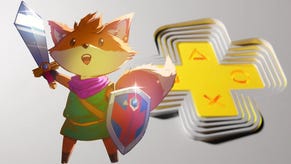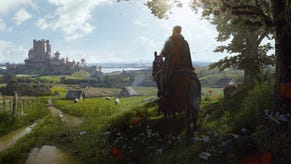Argonaut's X, the Rough Draft for Star Fox, Highlights the Compromises of Game Design
The most technically impressive work ever to appear on Game Boy reveals a harsh truth about the realities of making games.
This article first appeared on USgamer, a partner publication of VG247. Some content, such as this article, has been migrated to VG247 for posterity after USgamer's closure - but it has not been edited or further vetted by the VG247 team.
For nearly 20 years, Star Fox has stood as one of Nintendo's premiere game franchises. Granted, only a handful of Star Fox entries have qualified as true classics, but that simply serves as a testament to the impression that the first two games in the series (Star Fox for Super NES and Star Fox 64 for Nintendo 64) made on players.
The original Star Fox in particular was a true technical marvel: A fully 3D polygonal shooter on Super NES, a console that initially struggled to handle even 2D games thanks to its sluggish processor speed. Certainly Star Fox wasn't the first game to sport such advanced graphics; SEGA's Virtua Racing had already seen the light of day in arcades by May 1993, when Star Fox debuted, and the stunning Virtua Fighter was just around the corner. Atari had been dabbling in 3D action for even longer, with Hard Drivin' establishing a direct line of inspiration for Virtua Racing back in 1989. Star Fox's accomplishment was to bring arcade-quality 3D visuals to a console, and one never designed for the task. Well, more or less. Unlike SEGA's Model 1 3D games, which ran at a comfortable 30 frames per second, Star Fox sent players chopping through space at about 12fps — and even that sputtery frame rate was only made possible through use of a "windowed" view that surrounded the live game visual space with a solid black border.
Star Fox also demanded a second, more significant cheat: The cartridge included an entire math coprocessor on its ROM board. Designated the FX chip, the board that powered Star Fox essentially amounted to a GPU that in some respects contained more power than the Super NES's processor. The console itself could perform some impressive faux-3D effects, but those were simple illusions; prior to the FX chip, the Super NES had to rely on so-called Mode 7 tricks, named for the special built-in graphical mode that made it possible. Mode 7 could take a bitmap graphic and spin, stretch, distort, or shear it to create the impression of 3D movement. Yet if you stop and study Mode 7 games like F-Zero or Super Mario Kart, you'll discover their "three dimensional" backgrounds are nothing more than cleverly illustrated textures stretched across a flat plane.
Star Fox, however, was the real deal: Most objects in its world consisted of filled triangles, moving and shifting in a low-resolution application of the same technology that powers today's games. Unlike the racers in Super Mario Kart, who were bitmap sprites whose various poses were drawn from multiple angles, Star Fox's ships, enemies, environments, and energy beams existed as 3D objects that could move and display convincingly regardless of their movement or the player's point of view. It was a huge coup for the Super NES, seemingly putting the console on par with pricey competitors like the 3DO and the Atari Jaguar. Nintendo's strongest competitors, NEC and SEGA, couldn't offer comparable visuals even with their expensive CD-ROM add-ons. For example, Game Arts' SEGA CD shooter Silpheed featured 3D graphics, but only for the active game elements themselves; the game cheated visually by setting the action over pre-rendered backgrounds.
Yet impressive as Star Fox may have seemed to Nintendo fans in 1993, its technical accomplishments pale in comparison to those of its predecessor, a Japan-only release called X. Despite sharing a clear and direct connection to Star Fox — it was 3D space shooter developed by Star Fox co-creators Argonaut — X remains largely unknown among English-speaking Nintendo fans. Besides having never been fully localized, X also has the disadvantage of bearing a name that seems tantamount to search engine suicide (being a Japanese title, it fares somewhat better when written out phonetically as "Ekkusu"). But it certainly deserves greater fame than it currently enjoys, if only for the sheer brazen preposterousness of its ambitions. X attempted to give players a 3D combat experience akin to Star Fox 64, with open ground-based areas to explore and the ability to switch fluidly between terrestrial and aerial combat. The Super NES Star Fox, of course, worked strictly as a linear rail shooter. But even more insanely, X attempted to do all of this without an add-on chip... and it did it on Game Boy.
Yes: The humble little handheld system that sometimes choked and sputtered on basic 2D action somehow managed to support a free-roaming 3D action shooter. Its frame rates were pretty low, it used wireframe visuals rather than filled polygons, and it presented the action in a windowed view that turned about half the screen into a static display. Even so, X represented an attempt to do something no one else had ever done with the Game Boy hardware.
For developer Argonaut, though, X presented a natural step in the move from personal computers to consoles that so many UK developers undertook in the early ’90s. X in turn had its own precursor in the form of Starglider, a fast-paced first-person shooter the studio had created for Atari ST and Amiga way back in 1986. X plays a bit more slowly than Starglider — perhaps unavoidably, given the Game Boy's relatively meager power compared to those computers — but what it lacked in speed it made up for with complexity. Starglider had been a zippy, straightforward, one-hit-kill shooter inspired by Battlezone and the Star Wars vector arcade game; X added fuel management, a power-up inventory system, and a health meter, and it switched the action to a mission-based format on a planetary surface dotted with features and criss-crossed by tunnels connecting points of interest through first-person corridors.
The one drawback to X — and perhaps the factor that eventually scuttled its U.S. localization — was that as a game experience, it felt a little flat beyond its initial wow factor. The sensation of soaring through real-time 3D space on Game Boy is truly a stunning one, even after all these years; it carries with it the illicit thrill of getting away with something the system's designers clearly never intended. At the same time, though, X suffers from the same issue that's afflicted many of the Star Fox games that followed in its wake: Once you move away from the pure, direct thrill of rail shooting, the series' simple first-person design tends to collapse from its own lack of substance. Only once, in Star Fox 64, has the series managed to break from linear space combat in a truly satisfactory fashion, and that legacy of design difficulty began before Star Fox even existed.
It's hard to be too critical of Argonaut; X defied both expectations and logic in every respect, and it's a towering technical feat. Argonaut practically won the lottery by hiring not one but two programming geniuses, Jez San and Dylan Cuthbert, and they managed to wring seemingly impossible feats from Nintendo's handheld, which was designed to be cheap and energy-efficient, not to serve as the home of immersive 3D combat simulations. But for all its visual finesse, X demonstrates the all-too-common reality of game development: You can have technical sophistication, jaw-dropping innovation, or polished quality, but putting two of those into the same game is a tall order. Combining all three at once is practically unheard of; the rare works that do manage to score on all fronts tend to go down in history as all-time classics (e.g. Super Mario Bros., DOOM, Street Fighter II, etc.).
History hasn't seen X filed away under the "true classics" label, and not just because of its import-only obscurity. Nintendo (who published the game in Japan) flirted with the idea of releasing it in the U.S. under the name Lunar Chase — the half-working Lunar Chase ROM floating around the internet would seem to be sufficient proof of that — but even if the game had made its way into sweaty little American hands, it would still sit firmly in Game Boy's middle tier of releases alongside the platform's many other ambitious but flawed works. Perhaps the best point of reference for X would be Atlus' Cosmo Tank; in a sense, X plays like a more advanced version of Cosmo Tank's multi-format mission-based combination of shooting action and 3D mazes. The two games also share a similar unfinished quality, as though they both really needed another few months of play testing and refinement to really come into their own.
X's biggest failing comes from its general sense of aimlessness. The planet surface consists of an awful lot of nothing, and many missions involve roaming around in search of objectives. Once you've sorted out your goals for a given mission, you can replay it more efficiently by making use of the underground tunnels that operate as shortcuts... but that method still results in a great deal of trial and error your first time out of the gates. There's also the somewhat awkward design of the open flight sequences; certain enemies can only be taken down by taking flight, but you can only launch off specific ramps scattered around the surface, which often appear far from aerial targets. Again, X involves a great deal of casting about aimlessly in search of targets and objectives, and the illicit thrill of 3D action on such an unlikely platform ultimately fades in the face of an endless sweep of the horizon in search of mission objectives.
Games rarely manage to combine innovation, technical prowess, and flawless design altogether because, in the end, they're products of the real world. Time and money create hard limitations on just how much energy and effort any developer can invest into its products. Every developer tries to make the best game they can, but eventually reality intrudes. Still, even if X falls short on the gameplay and mission design front, its technical achievements made for more than just an interesting historical conversation piece: With this project, Argonaut and Nintendo made a connection that resulted in the birth of the Star Fox franchise and the development of the Super FX chip. Not many forgotten Game Boy creations can lay claim to such a remarkable legacy.












